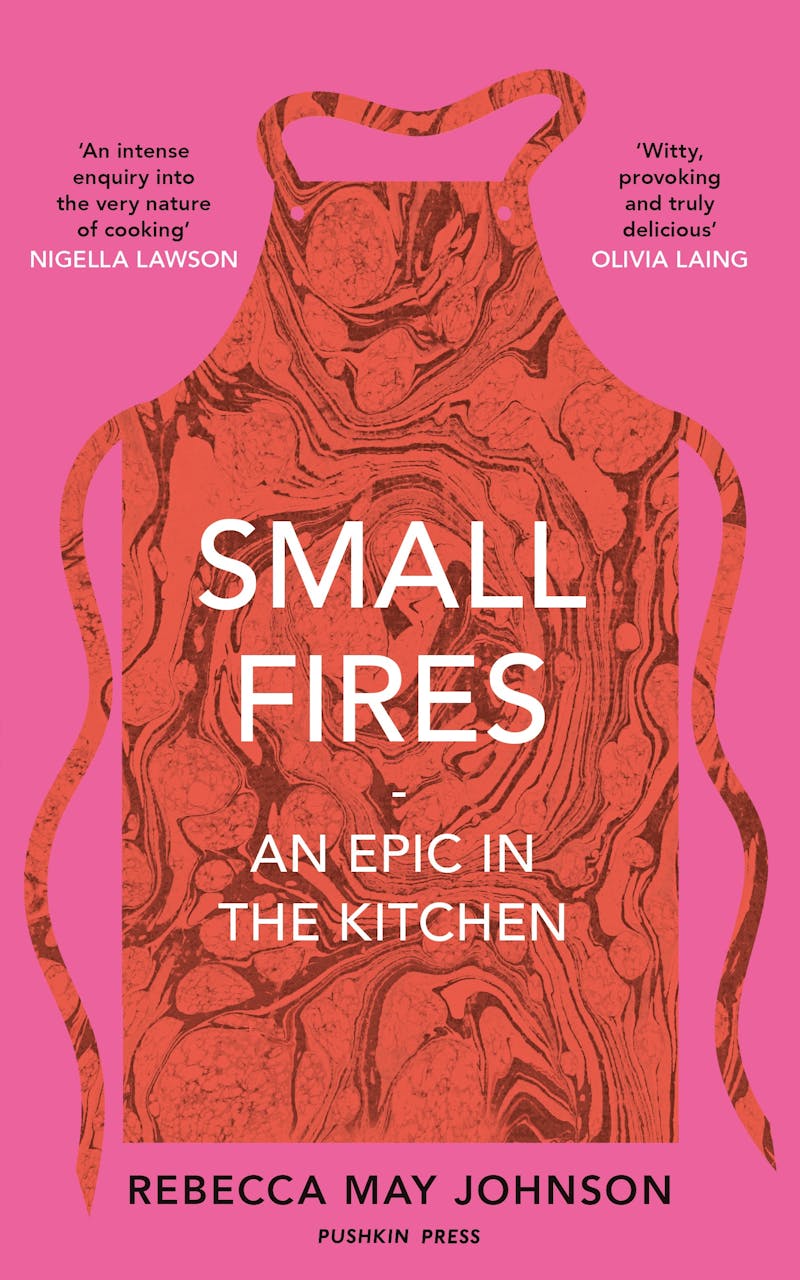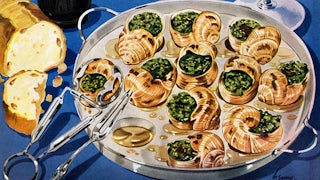Marcella Hazan’s recipe for spaghetti with fresh basil and tomato sauce was first published in 1973, though it likely originates in nineteenth- or early twentieth-century Italian cooking. Despite or perhaps because of its simplicity, it has been modified many times. As Hazan explains in The Classic Italian Cook Book, there is no single or “original” version of the dish. The laborers who traveled to Rome from the surrounding countryside to sell their wine and produce prepared many different variations: These men were “notoriously underpaid,” Hazan notes, and made use of whatever was available and least expensive, which changed with the seasons. They were known as carrettieri, after the elaborately painted wooden carts they used to transport their goods.
The dish, spaghettini alla carrettiera, has only four ingredients: basil, tomatoes, finely chopped garlic, and olive oil. (A Sicilian version that goes by the same name uses garlic, anchovies, chili flakes, and breadcrumbs.) These are all combined in a saucepan and brought to a simmer for 15 minutes. In keeping with the frugal nature of the dish, Hazan tells the reader it is served without cheese. “It has a very fresh, unlabored taste,” she writes.

Since her 1973 book, the recipe has undergone further revisions. In 1992, Hazan altered it slightly, folding the basil into the dish at the very end when the sauce and noodles are combined, instead of chopping and adding it at the beginning. Ruth Rogers, one of the founders of London’s celebrated River Café, put her own spin on it for a feature in The Guardian in 2006. She thinly slices the garlic and sautés it briefly in the olive oil before adding the tomatoes and cooking for about 20 minutes, “until the oil floats free of the tomatoes.” She also changes the quantities of garlic and basil used in the dish. Rogers attributes the recipe to Hazan’s 1997 book, Marcella Cucina, but it’s clearly drawn more from memory and practice: The recipe does not appear anywhere in that book. (Adding yet another layer to the recipe’s transformation, all Hazan’s books were written first in Italian and then translated into English by her husband, Victor Hazan, an Italian Jew who grew up in New York City.)
In any case, it is Rogers’s version of Hazan’s recipe that Rebecca May Johnson encounters not long after arriving at university in London and that serves, in many ways, as the foundation for her provocative book, Small Fires: An Epic in the Kitchen. Over the course of 10 years, Johnson makes the sauce at least a thousand times. She adds to it, creates more elaborate versions, and incorporates it into other cuisines altogether (shakshuka and lamb patties in sweet-spiced tomato sauce, for example). At one point, the 890th time to be precise, she makes it because there is nothing else in the cupboard and she has run out of money. “I am bored of it,” she declares, “and I don’t want to eat it; I resent it.” But in the end, she always returns to it.
It is through the ritual of cooking and eventually writing—the
two are very closely related for Johnson—that she begins to see the recipe as a
text every bit as worthy of serious attention as other forms of academic study.
Drawing on the work of feminist scholar and activist Silvia Federici, Johnson proposes
that “in writing about the recipe, I am writing about a form of knowledge that
is often denied the status of knowledge,” work that, like much women’s work in
the home, has often gone unacknowledged. Keenly aware of the assumptions that have
informed so much writing about food, Johnson seeks to restore cooking to its
rightful place as a form of knowledge—one through which pleasure, desire, and
resistance can be expressed.
Johnson’s culinary awakening begins, as it does for so many, when she leaves home for university and is introduced to a wide range of new foods and flavors. Through cooking, relationships are kindled. The kitchen, long associated with domesticity, takes on a kind of subversive quality. It becomes a space where freedom—specifically the sense of freedom that comes with living on one’s own—and desire meet. Fire, central to the image of the happy home, Johnson seems to imply, can also be used to burn it down.
Johnson grew up in rural England and describes her pre-university palate as “childish.” (Elsewhere, though, she mentions that her mom had Ruth Rogers’s River Café cookbook and for special occasions would make pork loin with vinegar, bay leaves, and peppercorns, among other dishes.) In London, she and the student next door share boxes of leftover beef rendang and papaya salad. They go to Krispy Kreme, new to London, and marvel at the ethereal quality of the donuts. She falls in with a group of Italians, one of whom, a Florentine, is a talented chef. Over the next 10 years, Johnson moves a dozen times, from apartment to apartment, neighborhood to neighborhood, all the while continuing to cook and document her experiences. (From 2011 to 2021 she kept an online diary of recipes called Dinner Document, which has since moved to Substack.)
One could imagine Johnson using these moves to offer a kind of tour d’horizon of London’s eateries as she works her way through the rigors of finishing a dissertation. Let’s call it eating (or cooking) as a form of self-discovery, where learning and eventually love overlap. This is more or less the standard arc of a genre that blends travel and food writing to arrive at a storybook ending. The narrative usually begins with some sort of crisis—typically a divorce or unexpected career change—followed by travel, a love affair with food, and then redemption. On this foundation, a new home is built.
Johnson takes a different path. She bristles at the
assumption that because she’s writing about food she must be “writing a lovely
book of lovely recipes that will be beautifully photographed.”
(There are no photos in her book and only a handful of recipes, including two
of Johnson’s own: “A Spell to Purge Melancholy on Halloween” and “Bad news
potatoes: for one, obviously.”) Food, she reminds us, can also be nightmarish.
Studying in Berlin one winter and feeling homesick, she buys a bag of oranges
from the supermarket. It is a way of honoring the advice she imagines her
mother would have given her. But when she peels the first orange the
flesh moves: It is full of maggots. Elsewhere she keeps a list of foods her
friends don’t eat, which gives her “creative constraints to work within.” There
are times when she has no interest in cooking or food but nevertheless keeps a
log of her eating habits. “Much writing about food is lovely and
comforting,” she writes, “but not all of it must be, and the feeling that it
should is a symptom of the culture that underestimates the recipe.”
Writers and scholars have not entirely ignored recipes as a
subject for serious study. Sylvia Plath, in her journals, once wrote that she
turned to the Joy of Cooking as if it were “a rare novel.” Worried that
she was succumbing to domesticity, she took comfort in the fact that Virginia
Woolf fought off depression by cleaning out her kitchen and cooking “haddock
and sausage.” More recently, Susan Leonardi, a professor emerita of English at
the University of Maryland, has treated recipes and cookbooks, including the Joy
of Cooking, as literary texts that merit closer reading. Some have taken up
the mantle. Laura Shapiro, the author of several books, including Something From the Oven: Reinventing Dinner in 1950s America, has used mass
circulation recipes among other historical documents to explore the
relationship between food and gender in twentieth-century America. Food
studies programs have proliferated, mirroring a growing interest in food
writing, the anthropology of food (sometimes referred to as foodways), and the
relationship between food and politics. Vittles,
the twice-weekly newsletter on food and culture where Johnson is an editor, is
a good example of the broader interest that has taken root.
Johnson reads recipes as closely as she would any other text, including the Odyssey, versions of which she is poring over for her Ph.D. Her chapter “consider the sausage!” (a play on M.F.K. Fisher’s 1941 book Consider the Oyster) is a clever critique of psychoanalyst D.W. Winnicott’s dismissive treatment of those who follow recipes. In a 1970 essay, Winnicott derided the use of recipes as “slavish,” the antithesis of living creatively. His case study was Mrs. Beeton’s method for cooking sausages from her 1861 Book of Household Management, perhaps because it is so straightforward. (Johnson refers to her as the “mother of all recipe writers” and sees in Winnicott’s choice an attempt to undermine her long-established authority.)
For Winnicott, in fact, the recipe is incidental. It has no meaning beyond the printed page. Somewhat in jest, Johnson sets out to test his theory, describing everything from her trip to the nearby butcher shop to the act of following Mrs. Beeton’s recipe, which in its brevity leaves much open to interpretation. (Mrs. Beeton says nothing about how much butter to put in the pan, for example, or how high the heat should be.) In Johnson’s hands, the recipe comes to life; it is part of a larger dialogue between past and present, cookbook author and cook, the self and others. And, in this case, Winnicott, she says, “sucks the life from the recipe and the recipe-follower (her), consuming them as raw material for his theorizing about what it is to live ‘creatively.’”
Similarly, Johnson works her way through Claudia Roden’s recipe for rice pudding (Reiz Kugel) in The Book of Jewish Food. Like Hazan’s tomato sauce, it’s one she’s been making for years, tinkering with the ingredients to accommodate the likes and dislikes of friends and lovers. During the pandemic lockdown, she makes it again and again because she has bags of “pudding rice” in her cupboard.
Naturally, Johnson begins to draw parallels between the many ways of translating an epic poem and the making and unmaking of a recipe. In other words, she sees recipe writing as a mode of translation: from the act of cooking—the carrettieri making their tomato sauce, for example—into the pages of a cookbook, which tells its own kind of story. Then the recipe enters a second act: from the cookbook into another kitchen where it has “infinite potential translators.” The recipe is neither the origin nor the final form of the dish. It allows for endless interpretations, which if you’re cooking the same thing over and over can be liberating.
Can the kitchen, a space so often associated with the drudgery of domestic labor and exploitation, free us from some of those same constraints?
Restaurant work and related industries such as agriculture and meatpacking are demanding, poorly paid, and typically performed by the most vulnerable among us: undocumented immigrants. It is hard to separate what we cook and ultimately put in our bodies from the larger inequities that underpin the systems of production. This Johnson alludes to at the outset: “Who cares if a cook makes the most delicious food if the conditions in which they work are exploitative? Who does that serve?” But much of what we eat is served—dressed up to conceal the way the animals were treated and the conditions in which the food was prepared—in precisely this manner.
Still, Johnson holds out some hope that the kitchen might have revolutionary potential. In a short chapter on Audre Lorde’s Zami: A New Spelling of My Name, she describes how Lorde’s mother, Linda, used the careful preparation of meals to carve out “a nourishing space in hostile territory” in the Jim Crow era. On a family trip to Washington, D.C., rather than submit to the humiliation of eating at a segregated lunch counter, she brings a picnic of roasted chicken, slices of brown bread and butter, cakes and pastries from a West Indian bakery, iced tea, sweet and dill pickles, “peaches with all the fuzz still on them,” a box of napkins, and a washcloth dampened with rosewater. Her refusal to eat on unequal terms was her way of not only providing for her family but, in Johnson’s words, demonstrating that “liberation must give dreams earthly form.”
Johnson cooks Hazan’s humble tomato sauce a thousand times, giving her own dreams and desires earthly form. But she’s done something more: In her mission to “blow up the kitchen and rebuild it to cook again,” she has in her own way expanded the possibility of what food writing is capable of. It can demystify, or as Johnson puts it somewhat awkwardly, “unromance” and complicate the kitchen. It can incorporate voices and forms, such as art, film, and biography, that have not always been considered in relation to food. It can look beyond the kitchen table to draw on other disciplines—literary theory, psychoanalysis, and urban studies to name just a few—to breathe new life into a familiar genre. In short, it can make us think—“cooking is thinking!” Johnson writes—instead of simply providing comfort or entertainment.
As I finished Small Fires, I found myself reexamining
my own relationship to food and cooking, to the recipes I’ve made over and over
with seemingly little thought, to the notes jotted down in the margins of
beloved cookbooks, and to meals shared with friends and family. I returned to the
kitchen with what felt like sharpened senses. Cooking itself, the handling of
ordinary ingredients and the repetition of familiar tasks, seemed richer, full
of possibility. It may not have been liberation, but I’ll take it.






